Additive Manufacturing vs. Subtractive: A Detailed Comparison
VerifiedAdded on 2023/06/06
|13
|2932
|239
Report
AI Summary
This report provides a comprehensive analysis of additive and subtractive manufacturing processes, highlighting their functionalities, limitations, and technological variations. It begins with an introduction to both manufacturing modules, followed by individual descriptions of traditional (CNC machining) and additive (3D printing) methods. A critical analysis compares the two systems based on technological platforms, part digitization, and performance metrics. The report also addresses the limitations of each method and offers recommendations for improvement, such as using advanced software for additive manufacturing and incorporating secondary technologies to reduce material wastage in subtractive manufacturing. The conclusion summarizes the key differences and advancements in both additive and subtractive manufacturing, emphasizing the importance of CAD, EBM, and DLM in their respective applications.
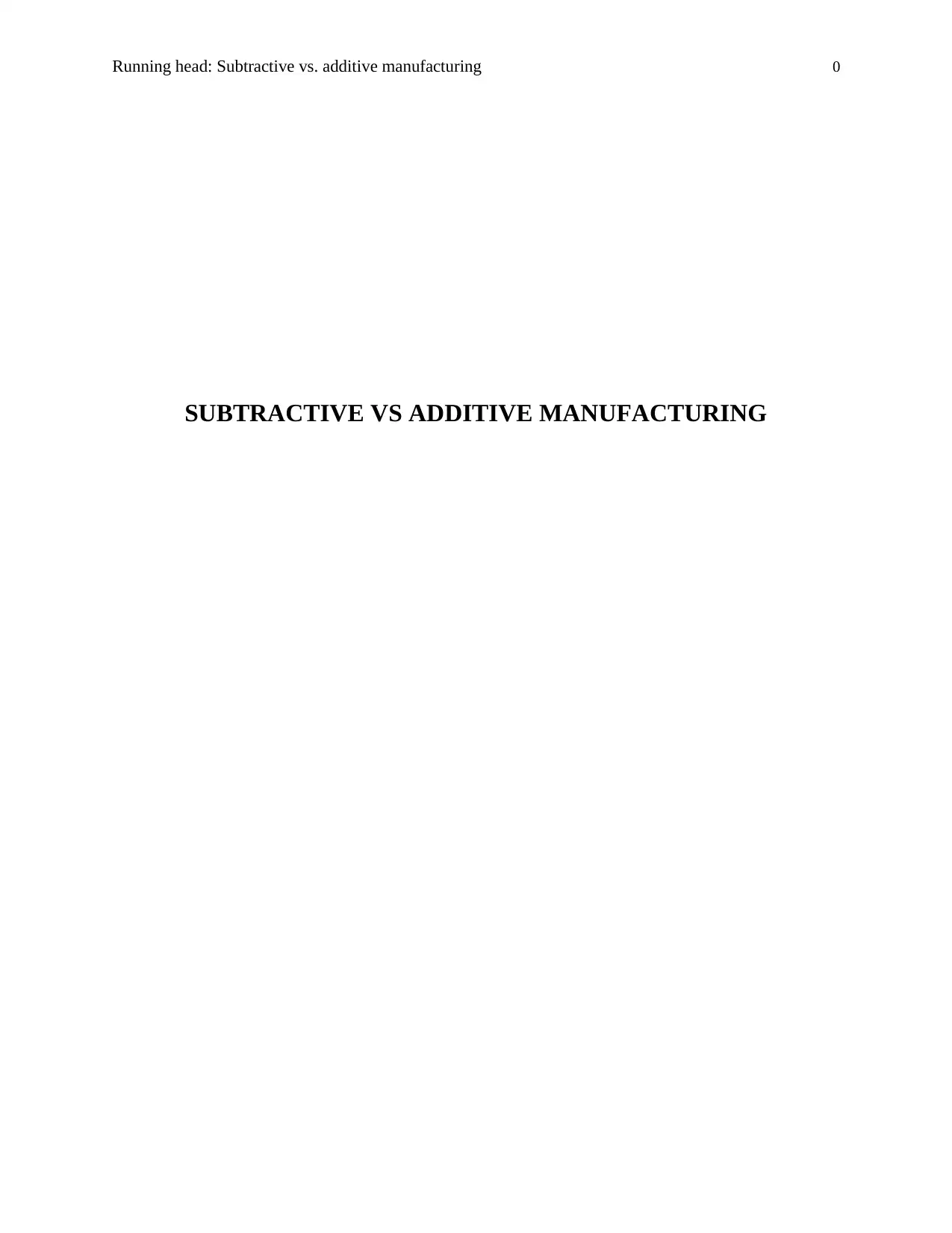
Running head: Subtractive vs. additive manufacturing 0
SUBTRACTIVE VS ADDITIVE MANUFACTURING
SUBTRACTIVE VS ADDITIVE MANUFACTURING
Paraphrase This Document
Need a fresh take? Get an instant paraphrase of this document with our AI Paraphraser
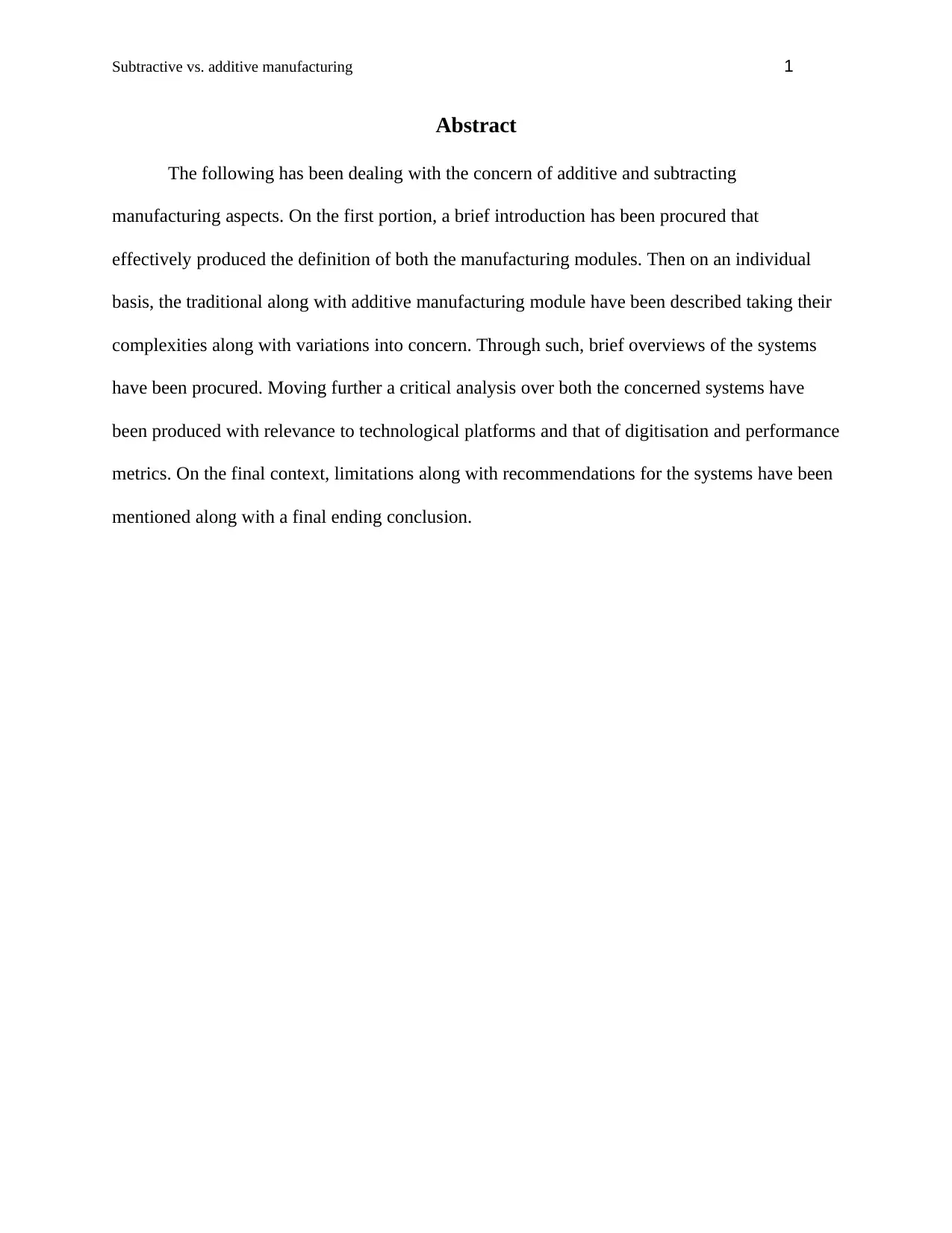
Subtractive vs. additive manufacturing 1
Abstract
The following has been dealing with the concern of additive and subtracting
manufacturing aspects. On the first portion, a brief introduction has been procured that
effectively produced the definition of both the manufacturing modules. Then on an individual
basis, the traditional along with additive manufacturing module have been described taking their
complexities along with variations into concern. Through such, brief overviews of the systems
have been procured. Moving further a critical analysis over both the concerned systems have
been produced with relevance to technological platforms and that of digitisation and performance
metrics. On the final context, limitations along with recommendations for the systems have been
mentioned along with a final ending conclusion.
Abstract
The following has been dealing with the concern of additive and subtracting
manufacturing aspects. On the first portion, a brief introduction has been procured that
effectively produced the definition of both the manufacturing modules. Then on an individual
basis, the traditional along with additive manufacturing module have been described taking their
complexities along with variations into concern. Through such, brief overviews of the systems
have been procured. Moving further a critical analysis over both the concerned systems have
been produced with relevance to technological platforms and that of digitisation and performance
metrics. On the final context, limitations along with recommendations for the systems have been
mentioned along with a final ending conclusion.
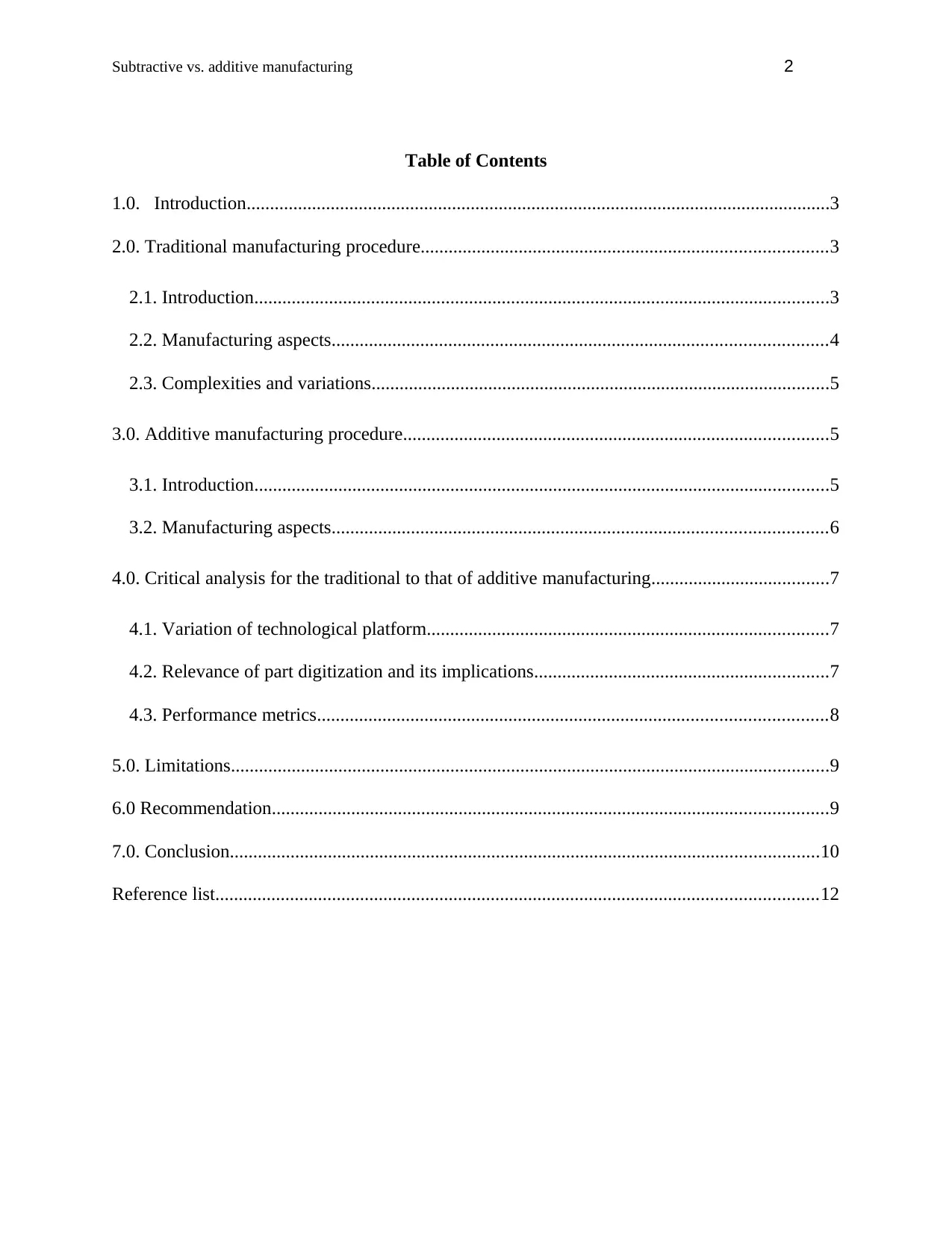
Subtractive vs. additive manufacturing 2
Table of Contents
1.0. Introduction.............................................................................................................................3
2.0. Traditional manufacturing procedure.......................................................................................3
2.1. Introduction...........................................................................................................................3
2.2. Manufacturing aspects..........................................................................................................4
2.3. Complexities and variations..................................................................................................5
3.0. Additive manufacturing procedure...........................................................................................5
3.1. Introduction...........................................................................................................................5
3.2. Manufacturing aspects..........................................................................................................6
4.0. Critical analysis for the traditional to that of additive manufacturing......................................7
4.1. Variation of technological platform......................................................................................7
4.2. Relevance of part digitization and its implications...............................................................7
4.3. Performance metrics.............................................................................................................8
5.0. Limitations................................................................................................................................9
6.0 Recommendation.......................................................................................................................9
7.0. Conclusion..............................................................................................................................10
Reference list.................................................................................................................................12
Table of Contents
1.0. Introduction.............................................................................................................................3
2.0. Traditional manufacturing procedure.......................................................................................3
2.1. Introduction...........................................................................................................................3
2.2. Manufacturing aspects..........................................................................................................4
2.3. Complexities and variations..................................................................................................5
3.0. Additive manufacturing procedure...........................................................................................5
3.1. Introduction...........................................................................................................................5
3.2. Manufacturing aspects..........................................................................................................6
4.0. Critical analysis for the traditional to that of additive manufacturing......................................7
4.1. Variation of technological platform......................................................................................7
4.2. Relevance of part digitization and its implications...............................................................7
4.3. Performance metrics.............................................................................................................8
5.0. Limitations................................................................................................................................9
6.0 Recommendation.......................................................................................................................9
7.0. Conclusion..............................................................................................................................10
Reference list.................................................................................................................................12
⊘ This is a preview!⊘
Do you want full access?
Subscribe today to unlock all pages.

Trusted by 1+ million students worldwide

Subtractive vs. additive manufacturing 3
1.0. Introduction
Manufacturing industry is taken to be a boon to the growing industrial aspects in today’s
world. For every manufacturing module, there stays a requirement for a prototype that produces
a schematic design for the product within a third dimension. For such, there are existence of
three production categories one being the additive manufacturing or (3D printing) and other
being the subtractive manufacturing (CNC machined) and moulded parts through injecting
procedure. Favouring such aspects the following content would be dealing with the aspects of
additive and that of subtractive manufacturing through their functionalities and their limitations.
Also a recommendation would be taken into consideration with a final conclusion, ending the
content.
2.0. Traditional manufacturing procedure
2.1. Introduction
The traditional manufacturing procedure comprising the concept of CNC machinery
stands for Numerical controlling through Computer aspects. Being the successor of Numerical
controlled machine, the CNC stands out to be efficient through having application of the
minicomputers and that of micro ones to act in form of machinery controlling unit. As mentioned
by Paris & Mandil (2017), the use of CNC is taken is taken into several industries featuring
metal fabrication or that of wood workings. Advancements within the subtractive manufacturing
industry now cater to CAD modelling through third dimension that efficiently reduces the coding
aspects being a time killing work.
1.0. Introduction
Manufacturing industry is taken to be a boon to the growing industrial aspects in today’s
world. For every manufacturing module, there stays a requirement for a prototype that produces
a schematic design for the product within a third dimension. For such, there are existence of
three production categories one being the additive manufacturing or (3D printing) and other
being the subtractive manufacturing (CNC machined) and moulded parts through injecting
procedure. Favouring such aspects the following content would be dealing with the aspects of
additive and that of subtractive manufacturing through their functionalities and their limitations.
Also a recommendation would be taken into consideration with a final conclusion, ending the
content.
2.0. Traditional manufacturing procedure
2.1. Introduction
The traditional manufacturing procedure comprising the concept of CNC machinery
stands for Numerical controlling through Computer aspects. Being the successor of Numerical
controlled machine, the CNC stands out to be efficient through having application of the
minicomputers and that of micro ones to act in form of machinery controlling unit. As mentioned
by Paris & Mandil (2017), the use of CNC is taken is taken into several industries featuring
metal fabrication or that of wood workings. Advancements within the subtractive manufacturing
industry now cater to CAD modelling through third dimension that efficiently reduces the coding
aspects being a time killing work.
Paraphrase This Document
Need a fresh take? Get an instant paraphrase of this document with our AI Paraphraser
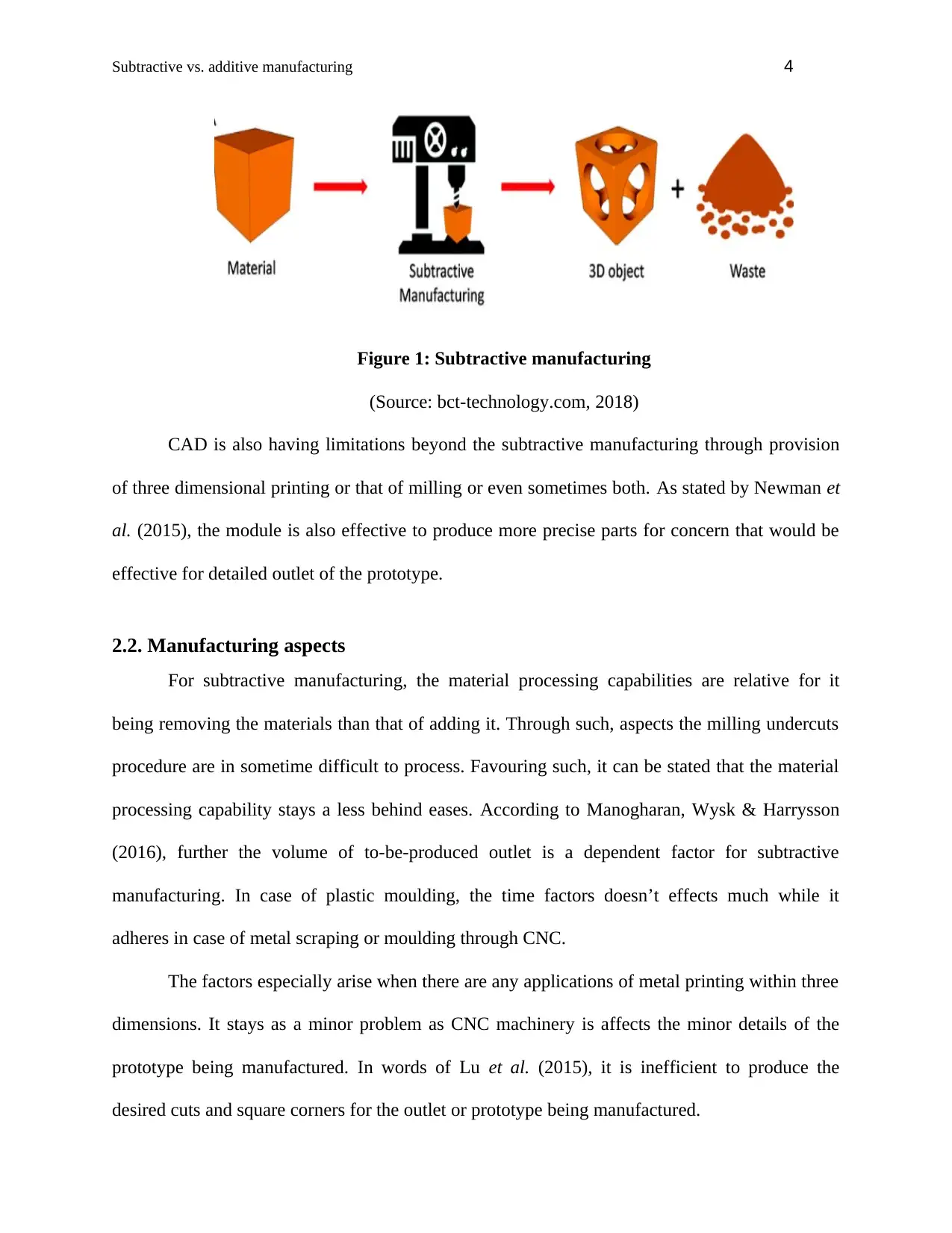
Subtractive vs. additive manufacturing 4
Figure 1: Subtractive manufacturing
(Source: bct-technology.com, 2018)
CAD is also having limitations beyond the subtractive manufacturing through provision
of three dimensional printing or that of milling or even sometimes both. As stated by Newman et
al. (2015), the module is also effective to produce more precise parts for concern that would be
effective for detailed outlet of the prototype.
2.2. Manufacturing aspects
For subtractive manufacturing, the material processing capabilities are relative for it
being removing the materials than that of adding it. Through such, aspects the milling undercuts
procedure are in sometime difficult to process. Favouring such, it can be stated that the material
processing capability stays a less behind eases. According to Manogharan, Wysk & Harrysson
(2016), further the volume of to-be-produced outlet is a dependent factor for subtractive
manufacturing. In case of plastic moulding, the time factors doesn’t effects much while it
adheres in case of metal scraping or moulding through CNC.
The factors especially arise when there are any applications of metal printing within three
dimensions. It stays as a minor problem as CNC machinery is affects the minor details of the
prototype being manufactured. In words of Lu et al. (2015), it is inefficient to produce the
desired cuts and square corners for the outlet or prototype being manufactured.
Figure 1: Subtractive manufacturing
(Source: bct-technology.com, 2018)
CAD is also having limitations beyond the subtractive manufacturing through provision
of three dimensional printing or that of milling or even sometimes both. As stated by Newman et
al. (2015), the module is also effective to produce more precise parts for concern that would be
effective for detailed outlet of the prototype.
2.2. Manufacturing aspects
For subtractive manufacturing, the material processing capabilities are relative for it
being removing the materials than that of adding it. Through such, aspects the milling undercuts
procedure are in sometime difficult to process. Favouring such, it can be stated that the material
processing capability stays a less behind eases. According to Manogharan, Wysk & Harrysson
(2016), further the volume of to-be-produced outlet is a dependent factor for subtractive
manufacturing. In case of plastic moulding, the time factors doesn’t effects much while it
adheres in case of metal scraping or moulding through CNC.
The factors especially arise when there are any applications of metal printing within three
dimensions. It stays as a minor problem as CNC machinery is affects the minor details of the
prototype being manufactured. In words of Lu et al. (2015), it is inefficient to produce the
desired cuts and square corners for the outlet or prototype being manufactured.
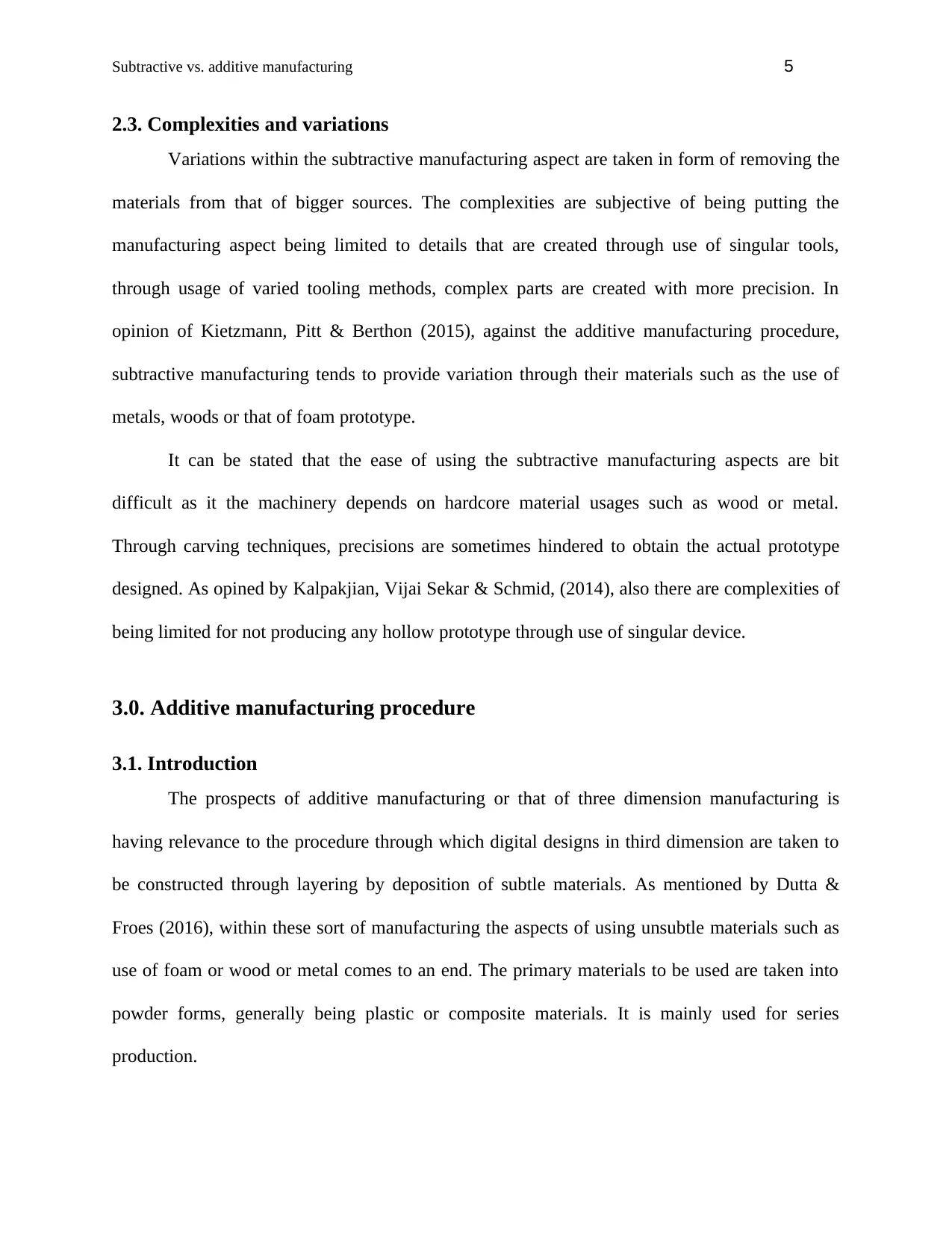
Subtractive vs. additive manufacturing 5
2.3. Complexities and variations
Variations within the subtractive manufacturing aspect are taken in form of removing the
materials from that of bigger sources. The complexities are subjective of being putting the
manufacturing aspect being limited to details that are created through use of singular tools,
through usage of varied tooling methods, complex parts are created with more precision. In
opinion of Kietzmann, Pitt & Berthon (2015), against the additive manufacturing procedure,
subtractive manufacturing tends to provide variation through their materials such as the use of
metals, woods or that of foam prototype.
It can be stated that the ease of using the subtractive manufacturing aspects are bit
difficult as it the machinery depends on hardcore material usages such as wood or metal.
Through carving techniques, precisions are sometimes hindered to obtain the actual prototype
designed. As opined by Kalpakjian, Vijai Sekar & Schmid, (2014), also there are complexities of
being limited for not producing any hollow prototype through use of singular device.
3.0. Additive manufacturing procedure
3.1. Introduction
The prospects of additive manufacturing or that of three dimension manufacturing is
having relevance to the procedure through which digital designs in third dimension are taken to
be constructed through layering by deposition of subtle materials. As mentioned by Dutta &
Froes (2016), within these sort of manufacturing the aspects of using unsubtle materials such as
use of foam or wood or metal comes to an end. The primary materials to be used are taken into
powder forms, generally being plastic or composite materials. It is mainly used for series
production.
2.3. Complexities and variations
Variations within the subtractive manufacturing aspect are taken in form of removing the
materials from that of bigger sources. The complexities are subjective of being putting the
manufacturing aspect being limited to details that are created through use of singular tools,
through usage of varied tooling methods, complex parts are created with more precision. In
opinion of Kietzmann, Pitt & Berthon (2015), against the additive manufacturing procedure,
subtractive manufacturing tends to provide variation through their materials such as the use of
metals, woods or that of foam prototype.
It can be stated that the ease of using the subtractive manufacturing aspects are bit
difficult as it the machinery depends on hardcore material usages such as wood or metal.
Through carving techniques, precisions are sometimes hindered to obtain the actual prototype
designed. As opined by Kalpakjian, Vijai Sekar & Schmid, (2014), also there are complexities of
being limited for not producing any hollow prototype through use of singular device.
3.0. Additive manufacturing procedure
3.1. Introduction
The prospects of additive manufacturing or that of three dimension manufacturing is
having relevance to the procedure through which digital designs in third dimension are taken to
be constructed through layering by deposition of subtle materials. As mentioned by Dutta &
Froes (2016), within these sort of manufacturing the aspects of using unsubtle materials such as
use of foam or wood or metal comes to an end. The primary materials to be used are taken into
powder forms, generally being plastic or composite materials. It is mainly used for series
production.
⊘ This is a preview!⊘
Do you want full access?
Subscribe today to unlock all pages.

Trusted by 1+ million students worldwide
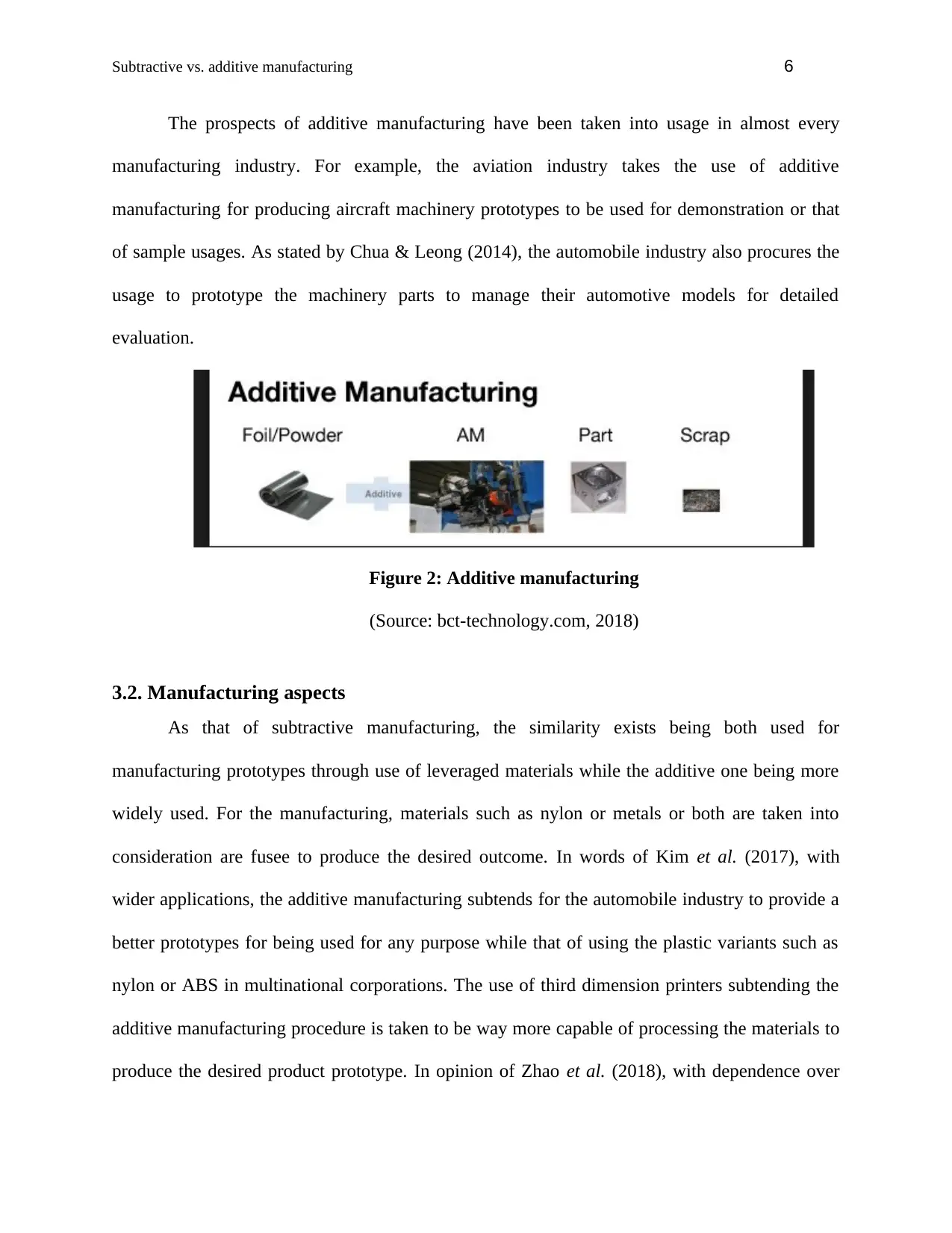
Subtractive vs. additive manufacturing 6
The prospects of additive manufacturing have been taken into usage in almost every
manufacturing industry. For example, the aviation industry takes the use of additive
manufacturing for producing aircraft machinery prototypes to be used for demonstration or that
of sample usages. As stated by Chua & Leong (2014), the automobile industry also procures the
usage to prototype the machinery parts to manage their automotive models for detailed
evaluation.
Figure 2: Additive manufacturing
(Source: bct-technology.com, 2018)
3.2. Manufacturing aspects
As that of subtractive manufacturing, the similarity exists being both used for
manufacturing prototypes through use of leveraged materials while the additive one being more
widely used. For the manufacturing, materials such as nylon or metals or both are taken into
consideration are fusee to produce the desired outcome. In words of Kim et al. (2017), with
wider applications, the additive manufacturing subtends for the automobile industry to provide a
better prototypes for being used for any purpose while that of using the plastic variants such as
nylon or ABS in multinational corporations. The use of third dimension printers subtending the
additive manufacturing procedure is taken to be way more capable of processing the materials to
produce the desired product prototype. In opinion of Zhao et al. (2018), with dependence over
The prospects of additive manufacturing have been taken into usage in almost every
manufacturing industry. For example, the aviation industry takes the use of additive
manufacturing for producing aircraft machinery prototypes to be used for demonstration or that
of sample usages. As stated by Chua & Leong (2014), the automobile industry also procures the
usage to prototype the machinery parts to manage their automotive models for detailed
evaluation.
Figure 2: Additive manufacturing
(Source: bct-technology.com, 2018)
3.2. Manufacturing aspects
As that of subtractive manufacturing, the similarity exists being both used for
manufacturing prototypes through use of leveraged materials while the additive one being more
widely used. For the manufacturing, materials such as nylon or metals or both are taken into
consideration are fusee to produce the desired outcome. In words of Kim et al. (2017), with
wider applications, the additive manufacturing subtends for the automobile industry to provide a
better prototypes for being used for any purpose while that of using the plastic variants such as
nylon or ABS in multinational corporations. The use of third dimension printers subtending the
additive manufacturing procedure is taken to be way more capable of processing the materials to
produce the desired product prototype. In opinion of Zhao et al. (2018), with dependence over
Paraphrase This Document
Need a fresh take? Get an instant paraphrase of this document with our AI Paraphraser

Subtractive vs. additive manufacturing 7
the materials, other manufacturing aspects can be taken such as laser sintering or stereo
lithography.
4.0. Critical analysis for the traditional to that of additive manufacturing
4.1. Variation of technological platform
The technological platform of both the additive and that of subtractive manufacturing
differs through having varied aspects. Regarding such the technological aspects behind additive
manufacturing summons the materials suitability sustaining those with lower melting points or
example plastic while that of the subtractive manufacturing without any such boundations. As
opined by Yoon et al. (2014), the technological background of additive manufacturing depends
upon deposition modelling through fusion while that of subtractive one subtends to scraping of
metals or wood to produce the prototype.
Furthermore there are available lesser or no losses of materials in case of additive
manufacturing to that of subtractive manufacturing. As mentioned by Paris & Mandil (2017),
technological advances in additive mode takes the help of the laser sintering along with melting
of electron beams, while that of subtractive manufacturing, it caters to the use of EBM or that of
DLMS.
4.2. Relevance of part digitization and its implications
The digitisation can be referred to that of the software used for the both the
manufacturing modules namely the additive and that of subtractive. For additive manufacturing,
there exists the use of software’s PTC Creo 3. The software is effective for undertaking
designing aspects along with optimising along with preparation and validating the design
regarding the printing of outlet in third dimension. As stated by Newman et al. (2015), apart
the materials, other manufacturing aspects can be taken such as laser sintering or stereo
lithography.
4.0. Critical analysis for the traditional to that of additive manufacturing
4.1. Variation of technological platform
The technological platform of both the additive and that of subtractive manufacturing
differs through having varied aspects. Regarding such the technological aspects behind additive
manufacturing summons the materials suitability sustaining those with lower melting points or
example plastic while that of the subtractive manufacturing without any such boundations. As
opined by Yoon et al. (2014), the technological background of additive manufacturing depends
upon deposition modelling through fusion while that of subtractive one subtends to scraping of
metals or wood to produce the prototype.
Furthermore there are available lesser or no losses of materials in case of additive
manufacturing to that of subtractive manufacturing. As mentioned by Paris & Mandil (2017),
technological advances in additive mode takes the help of the laser sintering along with melting
of electron beams, while that of subtractive manufacturing, it caters to the use of EBM or that of
DLMS.
4.2. Relevance of part digitization and its implications
The digitisation can be referred to that of the software used for the both the
manufacturing modules namely the additive and that of subtractive. For additive manufacturing,
there exists the use of software’s PTC Creo 3. The software is effective for undertaking
designing aspects along with optimising along with preparation and validating the design
regarding the printing of outlet in third dimension. As stated by Newman et al. (2015), apart

Subtractive vs. additive manufacturing 8
from such, the use of CAD is also taken into consideration. Using CAD, the basic of drawing can
be formed through specified dimensions and then converting it into a model of third dimension.
For subtractive manufacturing, th software advances to GibbsCAM that is effective for
improving production along with its efficiency. According to Manogharan, Wysk & Harrysson
(2016), through such, empowering of numerical controlling aspects can be taken into
consideration through solid modelling along with multi axis milling.
4.3. Performance metrics
Resolution Additive manufacturing outlets can have
higher resolutions of up to 10 to 295 microns
within layered heights, while the subtractive
manufacturing can layer up to a maximum of
1500 cubic inches.
Quality Both prototype manufacturing systems of
additive and subtractive produces favourable
quality products, but in case of detailed
outcome, the additive system is taken to be at
higher priority.
Production time Lesser production time for additive
manufacturing while higher production time
of subtractive manufacturing.
Table 1: Metric of additive and subtractive manufacturing
(Source: Created by author)
from such, the use of CAD is also taken into consideration. Using CAD, the basic of drawing can
be formed through specified dimensions and then converting it into a model of third dimension.
For subtractive manufacturing, th software advances to GibbsCAM that is effective for
improving production along with its efficiency. According to Manogharan, Wysk & Harrysson
(2016), through such, empowering of numerical controlling aspects can be taken into
consideration through solid modelling along with multi axis milling.
4.3. Performance metrics
Resolution Additive manufacturing outlets can have
higher resolutions of up to 10 to 295 microns
within layered heights, while the subtractive
manufacturing can layer up to a maximum of
1500 cubic inches.
Quality Both prototype manufacturing systems of
additive and subtractive produces favourable
quality products, but in case of detailed
outcome, the additive system is taken to be at
higher priority.
Production time Lesser production time for additive
manufacturing while higher production time
of subtractive manufacturing.
Table 1: Metric of additive and subtractive manufacturing
(Source: Created by author)
⊘ This is a preview!⊘
Do you want full access?
Subscribe today to unlock all pages.

Trusted by 1+ million students worldwide
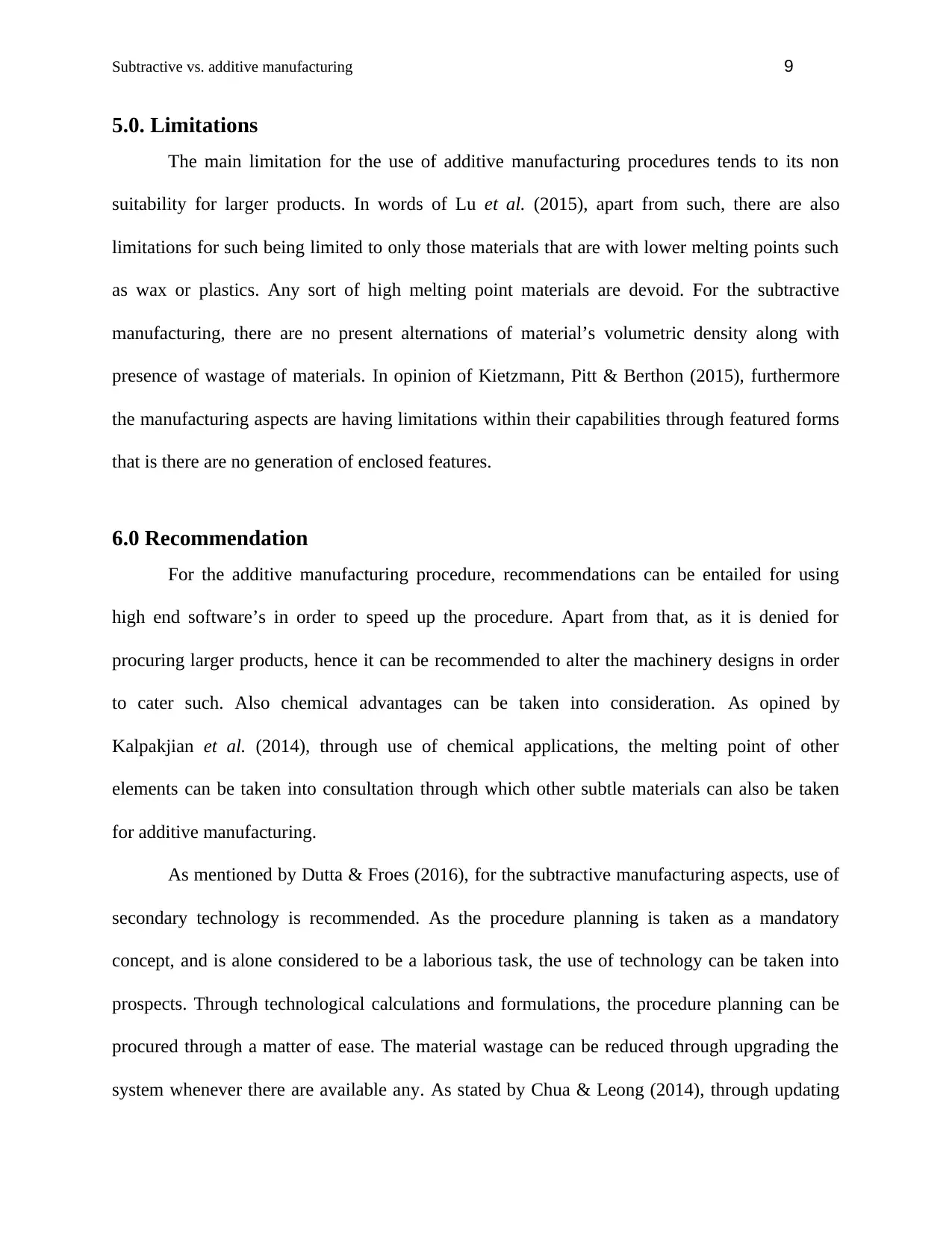
Subtractive vs. additive manufacturing 9
5.0. Limitations
The main limitation for the use of additive manufacturing procedures tends to its non
suitability for larger products. In words of Lu et al. (2015), apart from such, there are also
limitations for such being limited to only those materials that are with lower melting points such
as wax or plastics. Any sort of high melting point materials are devoid. For the subtractive
manufacturing, there are no present alternations of material’s volumetric density along with
presence of wastage of materials. In opinion of Kietzmann, Pitt & Berthon (2015), furthermore
the manufacturing aspects are having limitations within their capabilities through featured forms
that is there are no generation of enclosed features.
6.0 Recommendation
For the additive manufacturing procedure, recommendations can be entailed for using
high end software’s in order to speed up the procedure. Apart from that, as it is denied for
procuring larger products, hence it can be recommended to alter the machinery designs in order
to cater such. Also chemical advantages can be taken into consideration. As opined by
Kalpakjian et al. (2014), through use of chemical applications, the melting point of other
elements can be taken into consultation through which other subtle materials can also be taken
for additive manufacturing.
As mentioned by Dutta & Froes (2016), for the subtractive manufacturing aspects, use of
secondary technology is recommended. As the procedure planning is taken as a mandatory
concept, and is alone considered to be a laborious task, the use of technology can be taken into
prospects. Through technological calculations and formulations, the procedure planning can be
procured through a matter of ease. The material wastage can be reduced through upgrading the
system whenever there are available any. As stated by Chua & Leong (2014), through updating
5.0. Limitations
The main limitation for the use of additive manufacturing procedures tends to its non
suitability for larger products. In words of Lu et al. (2015), apart from such, there are also
limitations for such being limited to only those materials that are with lower melting points such
as wax or plastics. Any sort of high melting point materials are devoid. For the subtractive
manufacturing, there are no present alternations of material’s volumetric density along with
presence of wastage of materials. In opinion of Kietzmann, Pitt & Berthon (2015), furthermore
the manufacturing aspects are having limitations within their capabilities through featured forms
that is there are no generation of enclosed features.
6.0 Recommendation
For the additive manufacturing procedure, recommendations can be entailed for using
high end software’s in order to speed up the procedure. Apart from that, as it is denied for
procuring larger products, hence it can be recommended to alter the machinery designs in order
to cater such. Also chemical advantages can be taken into consideration. As opined by
Kalpakjian et al. (2014), through use of chemical applications, the melting point of other
elements can be taken into consultation through which other subtle materials can also be taken
for additive manufacturing.
As mentioned by Dutta & Froes (2016), for the subtractive manufacturing aspects, use of
secondary technology is recommended. As the procedure planning is taken as a mandatory
concept, and is alone considered to be a laborious task, the use of technology can be taken into
prospects. Through technological calculations and formulations, the procedure planning can be
procured through a matter of ease. The material wastage can be reduced through upgrading the
system whenever there are available any. As stated by Chua & Leong (2014), through updating
Paraphrase This Document
Need a fresh take? Get an instant paraphrase of this document with our AI Paraphraser
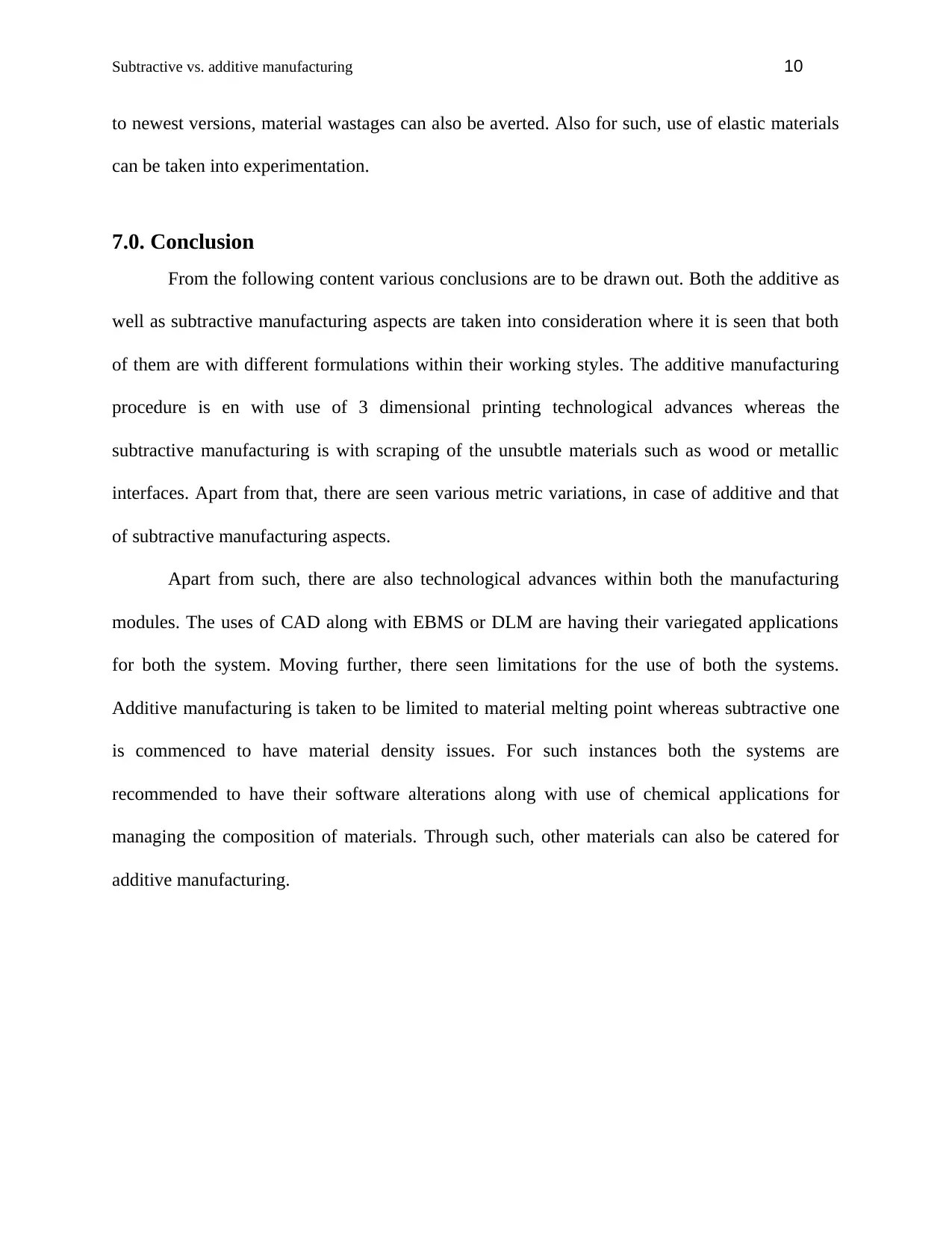
Subtractive vs. additive manufacturing 10
to newest versions, material wastages can also be averted. Also for such, use of elastic materials
can be taken into experimentation.
7.0. Conclusion
From the following content various conclusions are to be drawn out. Both the additive as
well as subtractive manufacturing aspects are taken into consideration where it is seen that both
of them are with different formulations within their working styles. The additive manufacturing
procedure is en with use of 3 dimensional printing technological advances whereas the
subtractive manufacturing is with scraping of the unsubtle materials such as wood or metallic
interfaces. Apart from that, there are seen various metric variations, in case of additive and that
of subtractive manufacturing aspects.
Apart from such, there are also technological advances within both the manufacturing
modules. The uses of CAD along with EBMS or DLM are having their variegated applications
for both the system. Moving further, there seen limitations for the use of both the systems.
Additive manufacturing is taken to be limited to material melting point whereas subtractive one
is commenced to have material density issues. For such instances both the systems are
recommended to have their software alterations along with use of chemical applications for
managing the composition of materials. Through such, other materials can also be catered for
additive manufacturing.
to newest versions, material wastages can also be averted. Also for such, use of elastic materials
can be taken into experimentation.
7.0. Conclusion
From the following content various conclusions are to be drawn out. Both the additive as
well as subtractive manufacturing aspects are taken into consideration where it is seen that both
of them are with different formulations within their working styles. The additive manufacturing
procedure is en with use of 3 dimensional printing technological advances whereas the
subtractive manufacturing is with scraping of the unsubtle materials such as wood or metallic
interfaces. Apart from that, there are seen various metric variations, in case of additive and that
of subtractive manufacturing aspects.
Apart from such, there are also technological advances within both the manufacturing
modules. The uses of CAD along with EBMS or DLM are having their variegated applications
for both the system. Moving further, there seen limitations for the use of both the systems.
Additive manufacturing is taken to be limited to material melting point whereas subtractive one
is commenced to have material density issues. For such instances both the systems are
recommended to have their software alterations along with use of chemical applications for
managing the composition of materials. Through such, other materials can also be catered for
additive manufacturing.

Subtractive vs. additive manufacturing 11
Reference list
Books
Chua, C. K., & Leong, K. F. (2014). 3D Printing and Additive Manufacturing: Principles and
Applications (with Companion Media Pack) of Rapid Prototyping Fourth Edition. World
Scientific Publishing Company. Retrieved from: https://bit.ly/2wSi9av
Dutta, B., & Froes, F. H. (2016). Additive manufacturing of Titanium alloys: state of the art,
challenges and opportunities. Butterworth-Heinemann. Retrieved from: https://bit.ly/2wHWim0
Kalpakjian, S., Vijai Sekar, K. S., & Schmid, S. R. (2014). Manufacturing engineering and
technology. Pearson. Retrieved from: https://cds.cern.ch/record/2318298
Journals
Kietzmann, J., Pitt, L., & Berthon, P. (2015). Disruptions, decisions, and destinations: Enter the
age of 3-D printing and additive manufacturing. Business Horizons, 58(2), 209-215. Retrieved
from: http://www.academia.edu/download/40666375/2015_3D_Printing_BH.pdf
Lu, B., Li, D., & Tian, X. (2015). Development trends in additive manufacturing and 3D
printing. Engineering, 1(1), 85-89. Retrieved from:
http://engineering.ckcest.cn/eng/EN/article/downloadArticleFile.do?attachType=PDF&id=12604
Manogharan, G., Wysk, R. A., & Harrysson, O. L. (2016). Additive manufacturing–integrated
hybrid manufacturing and subtractive processes: economic model and analysis. International
Journal of Computer Integrated Manufacturing, 29(5), 473-488. Retrieved from:
https://bit.ly/2wJgbJc
Newman, S. T., Zhu, Z., Dhokia, V., & Shokrani, A. (2015). Process planning for additive and
subtractive manufacturing technologies. CIRP Annals, 64(1), 467-470. Retrieved from:
http://opus.bath.ac.uk/44538/1/O20_Newman_Zhu_Dhokia_Shokrani_final.docx
Reference list
Books
Chua, C. K., & Leong, K. F. (2014). 3D Printing and Additive Manufacturing: Principles and
Applications (with Companion Media Pack) of Rapid Prototyping Fourth Edition. World
Scientific Publishing Company. Retrieved from: https://bit.ly/2wSi9av
Dutta, B., & Froes, F. H. (2016). Additive manufacturing of Titanium alloys: state of the art,
challenges and opportunities. Butterworth-Heinemann. Retrieved from: https://bit.ly/2wHWim0
Kalpakjian, S., Vijai Sekar, K. S., & Schmid, S. R. (2014). Manufacturing engineering and
technology. Pearson. Retrieved from: https://cds.cern.ch/record/2318298
Journals
Kietzmann, J., Pitt, L., & Berthon, P. (2015). Disruptions, decisions, and destinations: Enter the
age of 3-D printing and additive manufacturing. Business Horizons, 58(2), 209-215. Retrieved
from: http://www.academia.edu/download/40666375/2015_3D_Printing_BH.pdf
Lu, B., Li, D., & Tian, X. (2015). Development trends in additive manufacturing and 3D
printing. Engineering, 1(1), 85-89. Retrieved from:
http://engineering.ckcest.cn/eng/EN/article/downloadArticleFile.do?attachType=PDF&id=12604
Manogharan, G., Wysk, R. A., & Harrysson, O. L. (2016). Additive manufacturing–integrated
hybrid manufacturing and subtractive processes: economic model and analysis. International
Journal of Computer Integrated Manufacturing, 29(5), 473-488. Retrieved from:
https://bit.ly/2wJgbJc
Newman, S. T., Zhu, Z., Dhokia, V., & Shokrani, A. (2015). Process planning for additive and
subtractive manufacturing technologies. CIRP Annals, 64(1), 467-470. Retrieved from:
http://opus.bath.ac.uk/44538/1/O20_Newman_Zhu_Dhokia_Shokrani_final.docx
⊘ This is a preview!⊘
Do you want full access?
Subscribe today to unlock all pages.

Trusted by 1+ million students worldwide
1 out of 13
Your All-in-One AI-Powered Toolkit for Academic Success.
+13062052269
info@desklib.com
Available 24*7 on WhatsApp / Email
![[object Object]](/_next/static/media/star-bottom.7253800d.svg)
Unlock your academic potential
Copyright © 2020–2025 A2Z Services. All Rights Reserved. Developed and managed by ZUCOL.